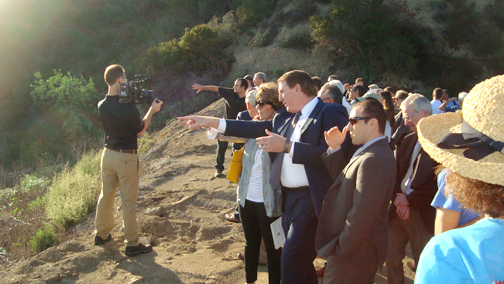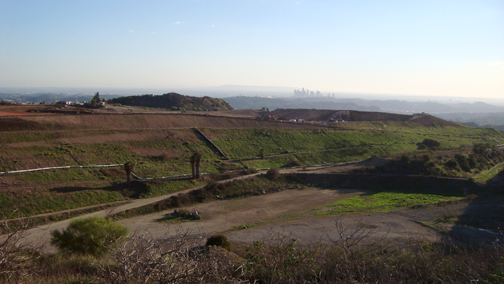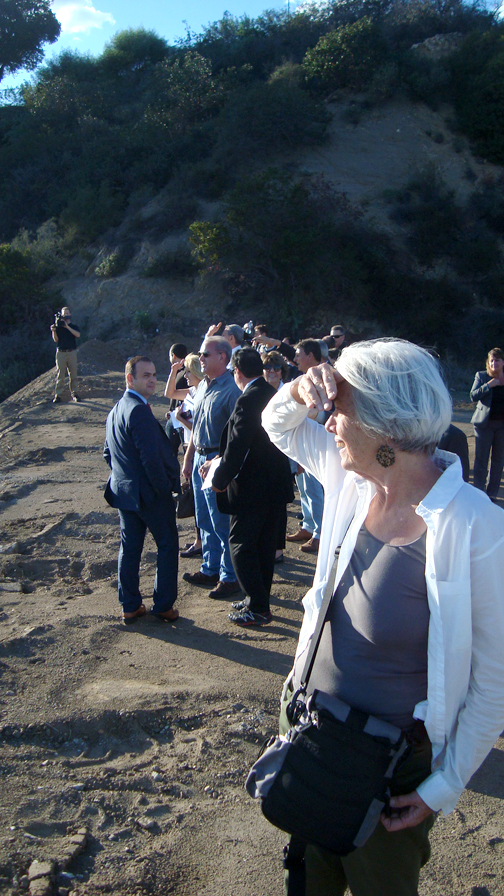
By Jason KUROSU
The Glendale City Council held its latest “workboot” meeting at the Glendale Fire Regional Training Center, overlooking the Scholl Canyon Landfill that is being considered for expansion.
As part of Glendale’s series of on-the-ground council sessions, city council members learned the ins and outs of the landfill’s daily operation and of potential methods for extending the use of the landfill, gearing up for an upcoming decision on whether or not to expand the site’s capacity.
City officials say the landfill has about 20 years of capacity left, assuming a daily intake of 1,400 tons of waste. Currently, about 440 of the site’s 535 acres are available for active landfilling, with the remainder used for site access, staff, parking and other uses. One-hundred-and-twenty-six of the 440 acres are filled.
If the expansion is approved, the landfill could be altered in one of two ways – by vertically raising the elevation by 180 feet or by expanding the site horizontally by 13 acres on the north edge of the landfill, in addition to raising the elevation. Officials say this expansion could extend the life of the landfill for another 13-19 years.
However, the meeting also addressed alternative methods for handling the burgeoning waste, such as the consideration of technologies for converting solid waste into useful by-products.
Anaerobic digestion was cited as the most viable form of waste conversion technology for the city, which involves using microorganisms to break down organic wastes.

Whether or not it will be implemented in Glendale during the next few years is uncertain though.
“We would love to be the first city that puts some anaerobic digestion in the area,” said Maurice Oillataguerre, Environmental Program administrator for Glendale Water & Power. However, Oillataguerre noted the potential for rapid developments in waste conversion technology and warned against spending “tens of millions of dollars on a technology that can change in three or four years.”
The use of waste conversion technology would also not preclude the city from using and/or expanding the landfill.
City Manager Scott Ochoa said that the ultimate vision for Scholl Canyon is that “we would pivot from a landfill that has a waste conversion or alternative technology component to being a waste conversion facility that has a landfilling component.”
“We view our solid waste options as a multi-tiered approach,” said Oillataguerre, who said that the landfill would be a necessary tier, particularly in the case of an earthquake or other natural disaster.

Oillataguerre said that only four other L.A. County landfills could accept the amount of waste generated in the Glendale area, with the closest being Sunshine Canyon Landfill in Sylmar. Scholl Canyon receives trash from areas within the “wasteshed area,” which includes the cities of Pasadena, Glendale, South Pasadena, San Marino, La Cañada Flintridge and Sierra Madre, as well as some unincorporated L.A. County areas.
The landfill receives an average of 1,000 tons of solid waste per day at present. This amount is down from 20 years ago, when the average was closer to 1,500 tons per day. City officials say a number of factors, including legislation mandating waste diversion and the recession, have influenced both municipal and individual attitudes towards waste.
The local availability of Scholl Canyon makes it “a huge asset to the city,” according to Oillataguerre.
Council member Paula Devine said that if common attitudes towards waste have changed among Glendale residents, it should not be assumed that those attitudes will revert back to more wasteful habits in the near future.
“Doesn’t that [raise] the question of why would we want to expand if people are changing their behavior? What’s to say that they’re all of a sudden going to change and go back to not recycling?”
Similarly, council member Laura Friedman questioned whether the landfill had to be expanded at all, considering the city’s inclination towards waste conversion technology.
“It sounds like our goals don’t align with the idea of expanding the landfill,” said Friedman. “Why not put all our resources into our goals and try to get to the point where we don’t have to expand the landfill at all?”
Oillataguerre said should the city utilize anaerobic digestion or other waste conversion technologies, that would only work for organic material, leaving other solid waste that must still be landfilled.
Several residents from Eagle Rock attended the meeting to voice their opposition to the landfill expansion. Though Eagle Rock does not utilize the landfill’s services, residents said that garbage trucks headed for Scholl Canyon have had a negative impact on local air quality, particularly on Figueroa Street and Colorado Boulevard.
Lauren Ballard, a representative for Los Angeles City Councilmember Jose Huizar, who represents the 14th City Council District which includes Eagle Rock, spoke on behalf of the councilmember regarding his opposition to the landfill expansion.
“The main impact felt by Eagle Rock is the steady stream of trucks, which causes pollution, noise and traffic. The proposed expansion offers no mitigation of any of these impacts,” said Ballard.
The draft EIR was released on March 31, 2014, with the EIR process dating back to 2007. Five months’ worth of public comments were accepted by the city and responses are expected sometime in November.
The City Council is expected to make a decision on the Scholl Canyon EIR “early next year,” said Ochoa.
